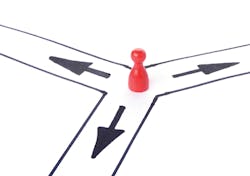Change in Your Commercial HVACR Business: When, Why, How
When is it time to make a major change, from altering your business offerings to making any type of office expansion?
It's a difficult question.
Let’s start with the following basic principle: the world is going to change, and since the world changes, as business people we must think about how the world changes, and how we're going to respond to those changes in the midst of our business.
One of the old and still absolutely great statements about life and business is, “if you do what you've always done you will always get what you always got”. That's a good statement for many air conditioning contractors who are successful at doing what they've always done.
Too much change is not good. If we're not careful, there could be way too much change that completely disrupts the organization that is comfortably familiar with the operation and set in its ways.
If you're successful, then your company has an expertise. The people in your company know how their process works and they have either refined and worked through that process to make it better and better, or they're just good enough to take the process they have and remain in business by making an unremarkable business process work.
But the world is going to change. That gives us pause. The pause gives us an opportunity and perhaps even a requirement to think about who we are today and what we are doing today going to be successful in the future.
For most HVAC contractors, too much change is probably not right. Assuming your company is already doing well, it's reasonable to assume that your organization is smart, effective and provides good client service. All in all, organizations like these are good at what they do. Given success, it seems reasonable to look at the current skill sets and work towards adding some new and different services.
Let's just say that a certain amount of change is good, such as adapting to social media or online scheduling. Another beneficial change might be adding professional expertise in building science and how to improve energy performance. Some of it might be changes of processes with electronic scheduling, and digital reporting, and performance base pay, and meeting our promises about energy efficiency, or confirming that, "we really were there, we really performed the mechanical service and the units are better now because we did it."
Another major change would be adding technical skills in VRF or expanding into commercial projects, or growing your commercial expertise to incorporate additional client types. These changes might be useful as adapted to the industry as a whole, and might help successful companies grow in their success or remain successful, despite the digital transformation that has begun to hound many businesses throughout the world.
When and why to change, expand, alter or adapt your business requires some really complex, audacious, tight decision making.
Change just for the sake of changing might be not only a bad idea but perhaps a disastrous one.
Sometimes companies are "good at what they're good at," and they need to put their head down and just focus on more effectively addressing new realities of the competitive world.
Too much change is not good. If we're not careful, there could be way too much change that completely disrupts the organization that is comfortably familiar with the operation and set in its ways. Undoubtedly, there will be a huge number of business opportunities and many sales people pounding on contractors’ doors saying “try this — do this —see how my new product or methodology works better — buy my service and you’ll have new skills — add my website to your website and the combined effect will keep you competitive in a rapidly changing digital world," and on and on, ad infinitum.
Risk in Being Static
It's risky to stay doing exactly what you're doing, and equally risky to make large and dramatic changes to what you're doing. Not too long ago, I talked to a software consultant who basically said way too many contractors say what they want, but later they find out that don’t really want what they say. A lot of us talk about change in broad terms. But the change that maybe required could be beyond the capacity or desire of the organization. Too much change could be too radical. Too little change could also be radical, because the marketplace may overwhelm you. It is a “damned if you do and damned if you don’t” scenario.
The leadership of businesses that are historically good in one model may find that their methodologies, personalities, and talent sets are not successful and adaptable to another model.
The world is full of examples of businesses who have changed and businesses that have not changed. The retailer J. C. Penny is the current text book example of the disaster of too much change. Lotus 1 2 3 is a good example of a company who let changes in another company's effort (Microsoft Excel) overwhelm them because they did not change fast enough and adapt. Lotus was absorbed into another company and really just died a quick and painful death. Microsoft itself is another cautionary tale. They have made so much money for many years. Yet, their success with the Office Suite has hamstrung them so deeply that they missed or passed on many business opportunities and have been left (by investors) for dead. They long term cash flow has kept them in business, but the long term forecast was terminal. The new CEO of Microsoft has bet his company on the Cloud and on collaboration. This is a radical change of corporate thought, philosophy and action. Early signs are promising but the long term viability are still in question.
When and why to change/expand/alter or adapt your business requires some really complex, audacious, tight decision making. I think one of the things it must also do is to get to the heart of who is leading the organization, and knowing their skill set and desire for the business.
For many companies, the desire is to make the most money! For those who plan on making the most money, and making it TODAY, change is particularly problematic. Change creates reductions in productivity. Change creates different processes. Change might be substantial enough that it shows a different style of business, a different kind of business. The leadership of businesses that are historically good in one model may find that their methodologies, personalities, and talent sets are not successful and adaptable to another model.
Many people (most?) do not want to change. Change is hard. Change is painful. Change is difficult. Change is expensive.
If you don’t change, you might be lucky enough to plug away for several years, and carve out all the money you need and want. Or, you might be able to your business transfer your business to others before change overcomes the inertia.
At Tempo, we both change and don’t change. Our outfit is like a battleship. It takes a long time to move the ship, regardless of the speed we desire. Whatever changes we make, nothing is particularly radical even if the long term effect might create a radical outcome. However, we are more diverse than most. We have a big machine in lots of different but related businesses. And, the machine powers on. Sometimes the power of the machine and the difficulty of changing the boat is good for us because the lack of change and resistance change keep us from losing too much productivity and keep us from moving and allows us to move forward with change in other places with the operating income that comes from divisions that are resistant to change.
But, I worry particularly about those divisions that if they don’t change one day they too will become a dinosaur. They too will experience the rapid deployment of what seems like an immediate change from other places where people already invested in the difference or who had no legacy system, and investing in a new world with simply their basic modus operandi.
So the answer to this question is, that there is no answer. There is no right answer. And, there are a lot of wrong answers. If you don’t change, you might be lucky enough to plug away for several years, and carve out all the money you need and want. Or, you might be able to your business transfer your business to others before change overcomes the inertia. Or, you might change too fast and the strategy you choose might not be where the market goes. That can be equally bad. Your company can experience the loss of productivity, the loss of people, and the loss of performance could also overwhelm the operating income you have and make you subject to risk should sudden disruption occurs.
A lot of contracting businesses (Tempo included) were caught too short of cash after the tragedy of September 11, 2001. Many (including Tempo) did not fully learn the lesson of a very strong cash position. Just a few years later, many (including Tempo) were again caught too short in cash during the period of economic turmoil in the fourth quarter of 2008 and year or two years beyond that. In Tempo’s case, change and the efforts we were making created both the painful realization of why we didn’t have cash and also the salvation in having had new things to offer — and it was the new service offerings that allowed us to generate the revenue and most importantly the gross margin in 2009 to keep us stable, keep us afloat and keep us from going under like so many of our good friends and quality competitors.
I don’t give you anything but a pause and a time to think about what is possible versus what is not possible versus what may keep your business afloat and what may cause it to go under. There is no right answer there are many wrong answers. I’m sorry not to help you more.
The answer is still out on our company, I like where we are going but sometimes it is a scary boat ride.

